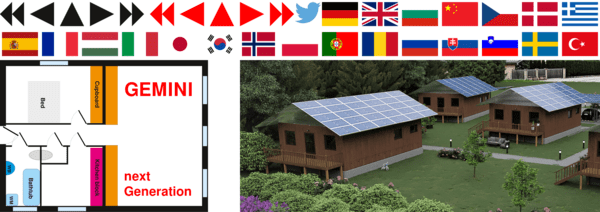How much energy should a house generate?As much as possible! Because we need to get out of oil, coal, biofuel, natural gas and uranium. Our houses should contribute as much as possible.Why this priority list when exiting?
2009 the IEA predicted a soon severe oil crisis , this was shifted by 10 to 20 years by the success of the Fracking in the USA. The Arab states make great efforts to prepare themselves for the time after the oil. We should do the same.
In contrast to oil, the supply situation here is secure and no major surprises are to be expected in terms of prices. But the CO2 emission per kWh of electricity generated is the highest here. CO2 Emissions are like a loan that we have to pay back once. Greenhouse gas emissions from thawing permafrost soils can develop into loan interest rates. If we hesitate for too long, this can lead to extreme high interest rates. Coal is not pure carbon, there are many impurities with other substances. For example, the death of forests had to be stopped with complex sulphur filters in coal-fired power plants. German coal-fired power plants emit 5 tons of mercury per year. You would have to break 2.5 billion energy-saving lamps to get the same amount of mercury. Energy-saving lamps have now been replaced by LED lamps, and coal-fired power stations continue to emit. Surprise! Surprise! Coal-fired power plants emit more radioactivity during normal operation than a nuclear power plant.
How much environmental destruction for an absolutely ridiculous result? 84 million tons of biofuels were produced worldwide in 2017. And what are we ruining for this ridiculous 2% of global oil production? What energy does produce more km for driving, biofuel or photovoltaics? Since 2014 it has been photovoltaics. 200 GW of photovoltaics produce as much km of driving as 84 million tons of biofuel. By 2017, photovoltaics already produces twice as much km of driving as the entire biofuel. Soon, the annual photovoltaic expansion will be every year greater than all the biofuel production. Wind power and photovoltaics correspond today (2019) already to 5 times of biofuel in the sense of driving a car. A single 5 MW wind power plant corresponds to 30 km² - 3,000 ha rape or sunflower in our country or 10 km² - 1,000 ha palm oil in a tropical country.
According to the current state of the art, power to gas, storage in existing underground gas storage facilities and electricity generation with the proven technology of combined cycle power plants is the most plausible variant for summer / winter balancing. In Germany, the limit from simply feeding into the grid to battery as intermediate storage is 70 GW photovoltaic and power to gas is needed at more than 300 GW. Fuel for the combined cycle power plants will then be replaced over decades from 100% natural gas to 100% methane from power to gas. Excess electricity from sunny summer days, so that everything continues to run at a dark lull. This also answers the question of what would happen on a sunny summer's day if all the houses had so much photovoltaics.
This niche product still manages to combine twice the amount of wind and solar energy. I just wrote that wind and solar energy can make five times as much driving a car than biofuel. But while all components for wind and solar power plants can be recycled again and again, nuclear power depends on very limited uranium supplies. As long as CCGT power plants are still operated with less than 50% power to gas methane, existing nuclear power plants should continue to operate. Nuclear power is uneconomical for new construction. 12 cents over 35 years with inflation compensation per kWh were necessary in Great Britain to motivate entrepreneurs to set up Hinkley Point C. Conditions solar power producers can only dream of. |
| Historical development and current statements |
This subdomain GEMINIs.pege.org and the subdomain Invests.pege.org shows the historical development of the project. GEMINI-next-Generation.house shows current statements of GEMINI next Generation AG.









